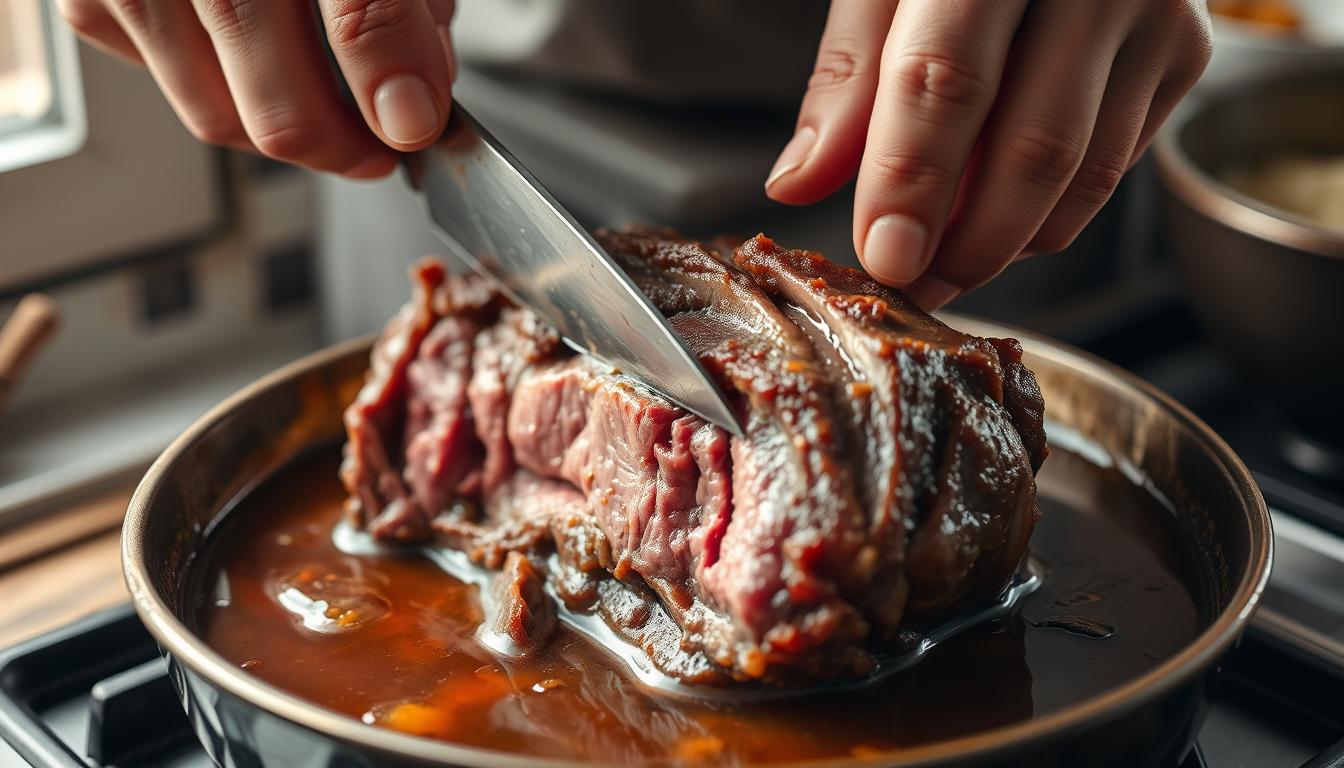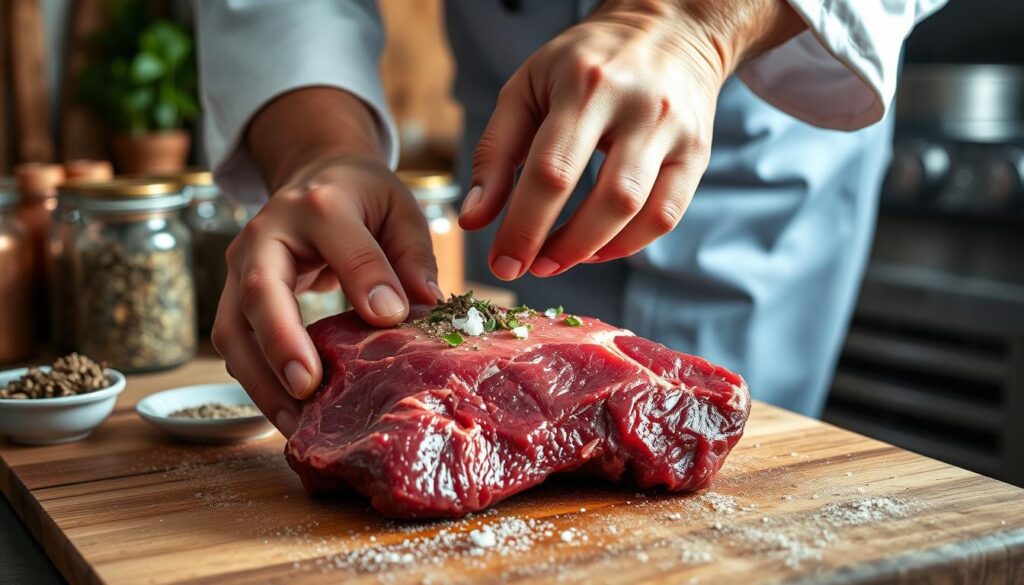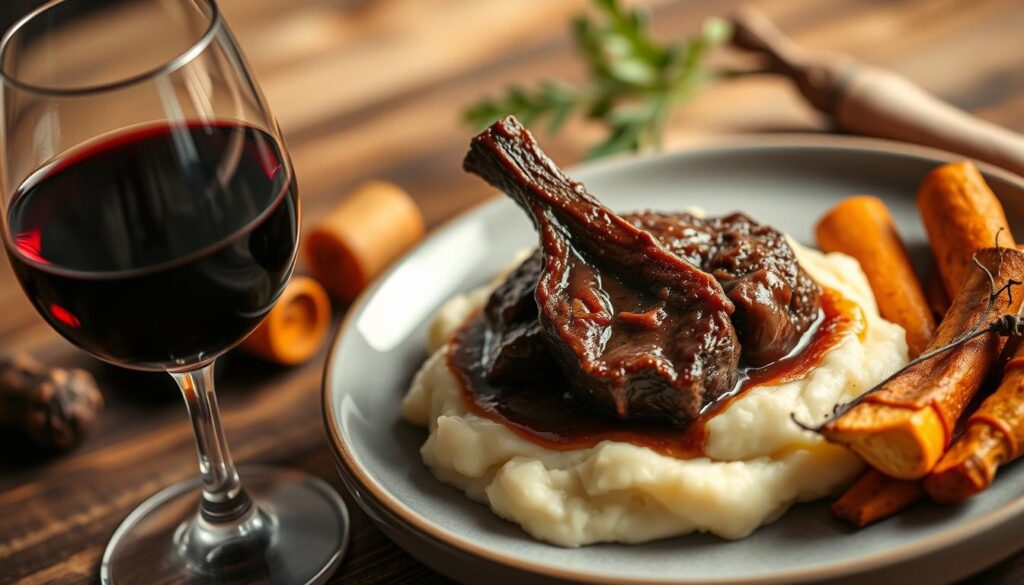Beef Cheek Meat: A Guide to Tender Slow Cooking

Every great culinary journey starts with a discovery. For me, that moment came in a small kitchen. There, the magic of turning tough meat into a succulent delicacy changed my cooking perspective. Beef cheek meat are that culinary alchemy – a cut that goes from tough to extraordinary with patience and skill.
When you first see beef cheek meat, you might wonder about their potential. These muscles work hard throughout a cow’s life, making the meat lean and tough. But, with the right recipes or a classic ground beef hash technique, you can unlock incredible tenderness. This surprises even experienced home cooks.
Beef cheek meat has a rich, deep flavor that makes home cooking extraordinary. By understanding its unique characteristics and mastering slow-cooking methods, you’ll get restaurant-quality results in your kitchen.
Table of Contents
Understanding Beef Cheek Anatomy and Characteristics
Beef cheeks are a fascinating cut of meat with great culinary potential. They are key to making dishes like beef and potato skillet taste amazing. Knowing how these muscles work is essential for tender and flavorful results.
The muscles in beef cheeks are unlike any other part of the cow. They are in the facial area and work hard as the animal chews. This constant effort makes these muscles special.
What Defines Beef Cheeks
Beef cheeks have a dense, well-marbled texture. The constant chewing and grazing make these muscles unique. This quality adds a rich flavor to dishes like beef and potato casserole.
- Constant muscle movement creates intense marbling
- High concentration of connective tissue
- Rich, deep flavor profile
Muscle Structure Explained
Beef cheek muscles have a lot of connective tissue. This makes the meat tender when slow-cooked. It breaks down collagen, creating a smooth texture that’s a joy to eat.
Why Beef Cheek Muscles Are Exceptional
The muscle structure of beef cheeks is truly special. They become tender with the right cooking. This makes them a favorite among chefs and home cooks.
The magic of beef cheeks lies in their ability to transform from tough to incredibly succulent with the right preparation.
The Rich History of Cooking with Beef Cheek Meat
Beef cheeks have a long and interesting history. They started as a simple ingredient in poor kitchens but are now a favorite in fancy cooking. Old ways of cooking, like in loaded potato meatloaf and shepherd’s pie, made these tough cuts tender and tasty.
Beef cheeks hold a special place in many cultures. In Europe, they were cooked slowly to make them soft. Poor families found creative ways to make cheap meat into tasty meals.
- Ancient cooking methods relied on long, slow braising
- Tough cuts were transformed through patient preparation
- Nothing from the animal went to waste
Every culture has its own way of cooking beef cheeks. French cuisine is famous for its slow cooking, while Mexican traditions make spicy stews. The trend of using all parts of the animal has made these cuts popular again.
| Region | Cooking Technique | Typical Dish |
|---|---|---|
| France | Slow Braising | Beef Bourguignon |
| Italy | Red Wine Reduction | Brasato al Barolo |
| Mexico | Spicy Stewing | Barbacoa |
Now, beef cheeks are a key ingredient in fancy restaurants. Chefs love them for their rich flavor and soft texture. They know that with the right cooking, these cuts can be truly amazing.
Nutritional Benefits and Health Value
Beef cheeks are packed with nutrients that can improve your health. They add flavor and essential nutrients to dishes like beef and potato soup or burritos.
beef cheek meat is a nutritional powerhouse. They offer health benefits that support your body’s functions.
Protein Content and Essential Nutrients
A 100-gram serving of beef cheek meat is a nutritional powerhouse:
- 20 grams of high-quality protein
- 14% of recommended daily iron intake
- 40% of recommended daily zinc intake
- 100% of recommended daily vitamin B12
Collagen Benefits for Health
beef cheek meat is rich in collagen. This protein is key for joint health and skin elasticity. It supports your body’s connective tissues and can enhance mobility.
Caloric and Fat Content Overview
Beef cheeks have about 240 calories and 18 grams of fat per 100 grams. Despite the fat, they are a nutrient-rich protein source. The fat makes the meat tender and helps your body absorb vitamins.
“Beef cheeks are not just a culinary delight, but a nutritional treasure trove for health-conscious food lovers.” – Culinary Nutrition Expert
Selecting and Preparing Beef Cheeks for Cooking
Choosing the right beef cheeks is key for tasty dishes like beef and potato tacos or empanadas. Look for fresh, high-quality meat. It should have a rich, deep red color and not too much fat.
- Color: Deep red with minimal brown or gray patches
- Texture: Firm and moist, without excessive dryness
- Fat content: Moderate marbling for enhanced flavor
- Smell: Fresh, clean meat without strong odors
Preparation is vital for tender, delicious meals. Start by trimming the fat and removing tough membranes. Sharp kitchen shears or a boning knife work best for precise trimming.
For the best results in your beef and potato dishes, follow these tips:
- Remove silver skin carefully to prevent tough texture
- Pat meat dry with paper towels before seasoning
- Season generously with salt and pepper
- Let meat rest at room temperature for 30 minutes before cooking
Marinading can make beef cheeks even more flavorful. Use marinades with acidic ingredients like citrus or vinegar. Marinate for 2-4 hours in the fridge for the best taste.
Essential Equipment for Perfect Beef Cheek Meat Preparation
Cooking beef cheeks needs special equipment to make them tender and tasty. The right tools in your kitchen can turn a good dish into an amazing one. This is especially true for ground beef and potato recipes or a hearty ground beef hash.
Choosing the right tools is key for delicious beef cheeks. The cooking process needs precision and patience.
Slow Cookers and Dutch Ovens: Your Culinary Companions
Slow cookers and Dutch ovens are essential for beef cheeks. They cook at low temperatures, breaking down tough fibers. Look for:
- Multiple heat settings
- Large capacity (at least 6 quarts)
- Durable ceramic or cast-iron construction
Precision Temperature Control
Accurate temperature control keeps beef cheeks juicy and tender. Invest in:
- Digital meat thermometers
- Instant-read temperature probes
- Programmable cooking devices
Essential Cutting and Trimming Tools
Good preparation starts with the right tools. A sharp, high-quality knife set is crucial for trimming beef cheeks:
- Boning knife
- Chef’s knife
- Cutting board with non-slip surface
Investing in these tools will improve your cooking and help you make restaurant-quality meals at home.
Mastering Basic Beef Cheek Cooking Techniques
Cooking beef cheeks needs patience and the right technique. This turns a tough cut into a delicious dish. Whether it’s a beef and potato skillet or a beef and potato casserole, knowing the basics is key. It ensures tender, flavorful results.

Braising is the top method for cooking beef cheeks. It involves a few important steps:
- Sear the beef cheek meat to get a rich, golden-brown crust
- Make a flavorful liquid base with broth, wine, or tomato sauce
- Slow cook the meat until it’s very tender
Choosing the right cooking method changes the texture and taste of beef cheeks:
- Slow Cooker Method: Great for easy, hands-off cooking, making it super tender
- Pressure Cooking: Makes the meat tender faster
- Smoking: Adds a deep, complex flavor
“The key to perfect beef cheeks is low and slow cooking that breaks down tough connective tissues.”
Your choice of cooking method depends on your time and flavor preference. A beef and potato skillet is perfect for quick meals. A beef and potato casserole offers a deeper cooking experience. Try different techniques to find your favorite way to cook these challenging cuts.
Classic Beef Cheek Recipes and Variations
Exploring beef cheek meat opens up a world of tasty dishes. From hearty home cooking to fancy restaurant meals, these cuts are incredibly versatile. They can change how you cook and make your meals special.
Beef cheek meat is perfect for creative cooking. They mix old cooking ways with new ideas. Whether you’re making a loaded potato meatloaf or a new take on shepherd’s pie, they add amazing flavor.
Traditional Braised Beef Cheek Meat
The traditional way to cook beef cheek meat is slow braising. This turns tough meat into tender, delicious bites. Your cooking method affects the dish’s texture and taste.
- Select high-quality beef cheeks with minimal external fat
- Season generously with herbs and spices
- Brown meat before slow cooking to enhance flavor
- Cook at low temperatures for 4-6 hours
Modern Fusion Interpretations
Today’s chefs are getting creative with beef cheeks. They make unexpected dishes with global flavors and cooking styles.
“Beef cheek meat is the ultimate canvas for culinary creativity” – Chef Michael Roberts
International Beef Cheek Dishes
Beef cheek meat is seen differently around the world. From Mexican barbacoa to French bourguignon, each culture has its own twist.
| Country | Signature Dish | Cooking Method |
|---|---|---|
| Mexico | Barbacoa | Slow-roasted in banana leaves |
| France | Bourguignon | Red wine braising |
| Italy | Brasato | Wine-infused stewing |
Starting your beef cheek journey means discovering rich flavors and tender textures. You’ll find endless recipe ideas to try.
Wine Pairing and Serving Suggestions

Improving your beef and potato soup or burritos is more than cooking well. The right wine can make your meal special.
Choose strong red wines for beef cheek dishes. They match the meat’s rich taste. Your wine should balance the dish’s bold flavors.
- Red Wine Recommendations:
- Cabernet Sauvignon: Great for braised beef cheek meat
- Malbec: Has bold tastes that match the meat’s richness
- Syrah: Adds spicy notes that go well with slow-cooked meats
Good presentation can make your meal better. Try serving your beef cheek meat dishes with:
- Warm sourdough baguette slices
- Creamy mashed potatoes
- Roasted seasonal veggies
Pro tip: Let your beef cheek dish rest for 10-15 minutes before serving. This lets the flavors settle and makes the meal better.
“The right wine doesn’t just accompany a meal—it completes it.” – Culinary Experts
Troubleshooting Common Cooking Issues
Cooking beef cheek meat can be tough, even for pros. Whether you’re making beef and potato tacos or empanadas, knowing how to fix common problems is key. This ensures your meal turns out delicious.
Every cook faces challenges. The trick is to quickly figure out and fix them.
Texture Problems and Solutions
Tough beef cheek meat can mess up your dish. Here’s how to make sure the meat is tender:
- Check meat after initial cooking time
- Extend cooking time if meat remains firm
- Use low, consistent heat
- Add liquid if meat appears dry
Temperature Management Tips
Getting the temperature right is crucial for perfect beef cheeks:
| Temperature Range | Cooking Result |
|---|---|
| 200-225°F | Ideal slow cooking zone |
| Below 200°F | Potential undercooking |
| Above 250°F | Risk of meat becoming tough |
Seasoning Adjustments
Getting the flavors right in beef and potato dishes takes careful seasoning. Taste as you cook and adjust little by little:
- Start with minimal seasoning
- Gradually add salt and spices
- Use acidic ingredients to brighten flavors
- Allow time for seasonings to develop
Cooking is all about patience and practice. Every problem is a chance to get better at cooking.
Storage and Leftover Management Tips
Storing your beef cheek meat right is key to keeping their taste and quality. Whether you’ve made a tasty ground beef hash or have leftovers, knowing how to store them is important. It helps keep your food fresh and flavorful.
For raw beef cheeks, here are some storage tips:
- Refrigerate immediately after buying
- Store in the coldest part of your fridge
- Use within 2-3 days
- Keep in original packaging or airtight container
Freezing is great for keeping beef cheek meat for a long time. Wrap beef cheeks tightly in freezer-safe packaging to avoid freezer burn. You can store frozen beef cheeks for up to 4 months. This way, you always have a tasty protein ready.
For leftover cooked beef, like ground beef hash, here’s how to reheat:
- Cool leftovers within two hours of cooking
- Store in shallow containers
- Reheat to an internal temperature of 165°F
- Consume within 3-4 days
Getting creative with leftovers can make your beef dishes even better. Turn yesterday’s ground beef and potato recipes into shepherd’s pie or beef hash. It’s a quick and tasty meal.
Pro tip: Always label your stored meals with the date to track freshness and prevent food waste.
Conclusion
Beef cheek meat is a true culinary treasure. They turn simple meals into unforgettable dining experiences. Whether you’re making a hearty beef and potato skillet or a rich casserole, these cuts add depth of flavor and texture.
Understanding beef cheek meat opens up new culinary possibilities. Their rich collagen and tenderness are perfect for slow-cooking. This brings out bold, complex flavors. Whether you’re a seasoned chef or just starting out, beef cheeks offer a chance to grow your cooking skills.
Your journey with beef cheeks is just starting. Try new recipes and techniques to master this meat. With practice, you’ll make simple dishes into restaurant-quality meals that wow everyone.
Take on the challenge and trust your cooking skills. Let beef cheeks become a key part of your kitchen. By following this guide, you’ll unlock new levels of creativity and satisfaction in your cooking.
